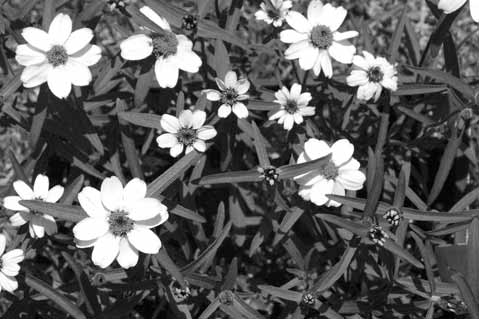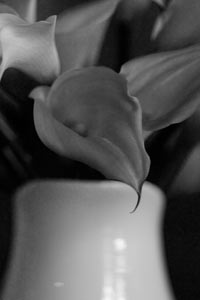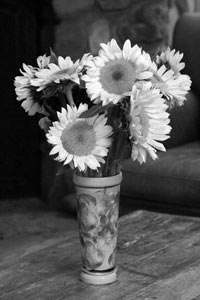The Cutting Garden
Fill Vases with Flowers, Foliage, and Twigs

In an area where there is a Farmers Market nearly every day of the week with buckets and buckets of inexpensive fresh flowers and open-air flower stands on corner after corner, it might seem that there is no need to grow flowers in your own garden for cutting. There is a real joy, though, in being able to simply walk outside with your shears and in a matter of minutes have a bouquet for your table or to take as a hostess gift. There are many different types of plants that produce colorful and long-lasting flowers and greens for your floral creations. Here are some of the easiest varieties to grow that last well after cutting.
Annuals
There’s nothing sweeter than the scent of sweet peas (Lathyrus odoratus). There are many different selections of these delicate-looking, but very sturdy flowers. Some are climbers, but there are also bush types that can stand on their own. Lisianthus or tulip gentian (Eustoma grandiflorum) flowers are often found in florists bouquets because they can be picked in bud and allowed to unfurl their perfect single or double whorls of petals. Growing your own allows you to enjoy a much wider range of colors and forms. Gypsophila elegans is also long-lasting in bouquets, and its masses of tiny flowers provide good filler in a vase as well as in the garden. Sunflowers (Helianthus annuus) have become a hit in the cut flower trade. They are easy to grow at home, and there are dozens of colors and sizes to choose from.
Cut flowers are best when they can last a long time and still look as fresh as when they were first picked. Others, like strawflower (Helichrysum bracteatum), are just as good-looking after they’ve dried. The papery bracts are colorful and even longer-lasting than regular cut flowers.
For bright and rich color, painted tongue (Salpiglossis sinuata) can’t be beat. Resembling their cousins the petunias, they come in shades of orange, red, yellow, purple, and pink, netted with darker lines. Keep cutting them and they will continue to bloom for months. Finally, an old favorite, zinnia. Plant the tall varieties to have pincushion flowers in every shade of the rainbow except blue.

Perennials
Lily of the Nile (Agapanthus selections and hybrids) flowers, in shades of blue and purple, grow in large heads that are as close to fireworks as you can get. Their sturdy stems work very well in composed arrangements. For extremely long-lasting cut flowers, nothing beats Alstroemeria. Sometimes called Peruvian lily, these brightly colored flowers look delicate, but are definitely not. For sunny yellow, several of the perennial species of coreopsis are nearly foolproof. Try Coreopsis lanceolata, C. maritime, or C. verticillata. Another popular dried flower, globe thistle (Echinops exaltatus), has golf-ball-sized flower heads. When the tiny flowers are fresh, they are metallic blue, but as they dry, the prickly globes still provide interest. The flower industry in our area is world-renowned and gerbera daisies (Gerbera jamesonii) are one of their premier products. Buy the locally grown ones or try your hand at growing your own.
Bulbs
Ornamental alliums, including Allium aflatunense, A. atropurpueum, A. caeruleum, A. carinatum pulchellum, A. cristophii, A. giganteum, A. karataviense, A. moly, A. narcissiflorum, A. neapolitanum, A. rosenbachianum are easy to grow from bulbs, and their large flower heads are highly ornamental. Several also dry well for fall arrangements.
Our warm, dry summers and cool, wet winters are ideal for growing naked ladies (Amaryllis belladonna). These bulbs send forth succulent flower stalks after the leaves have come and gone. They are topped with several large pink trumpet-shaped flowers. Just a few stalks create a stunning and fragrant centerpiece.

Hybrid freesias are also wonderfully fragrant. If you grow them in the garden, pick a few of their arching, sculptural inflorescences for a simple arrangement on their own, or let them poke out of the mixed bouquet. Calla lilies (Zantedeschia aethiopica) are also able to stand alone in an arrangement. There is nothing simpler, nor as perfect for any setting, than a dozen (or more!) callas in a glass cylinder.
You won’t find dahlias in your florist’s refrigerator, but they aren’t that hard to grow, and the variety of colors-including bicolors-and forms of these daisy relatives is monumental. Pick them often as they grow and they will reward you with even more flowers.
The haunting fragrance of tuberose (Polyanthes tuberosa) is reason enough to grow this flower. Single stems sell for as much as the bulb that produced them and the bulbs will continue to produce for many years.
Foliage
Don’t forget that a lovely flower arrangement or informal bouquet looks even better when you include some interesting greens. Ferns are a natural choice, and among the longest-lasting are sword fern (Nephrolepis exaltata) and leather fern (Rumohra adiantiformis). Maidenhair ferns (Adiantum species) also work well. Be sure to pick the fronds after they’ve hardened up; just emerging ones will probably wilt quickly.
Other good, sturdy greens can be found in your hedges: boxwood (Buxus species), podocarpus (Podocarpus gracilior), African boxwood (Myrsine africanus), even pittosporum. For certain arrangements, conifers such as pine, cedar, and juniper are just the background you need. Don’t overlook some of your succulent plants like elephant’s food (Portulacaria afra) or the juicy rosettes of Aeonium. Large, ornamental grasses like Miscanthus and Pennisetum add vertical elements.
Flax (Phormium cultivars), especially the variegated ones, are very dramatic, as are canna leaves. Citrus and other evergreen trees and shrubs like Prunus laurocerasus and Griselinia lend their shiny leaves as backdrops for your colorful flowers, too.
Twigs
Stunning flower arrangements always include some structural accent. Woody twigs provide the perfect foil for those softer floral elements. One of the most interesting is curly willow (Salix babylonica pekinensis ‘Tortuosa’). It will become a medium-sized tree, but it is as decorative in the landscape as its branches are in a vase. Pruned pieces from your deciduous fruit or ornamental trees and shrubs can also be saved for use all year.



